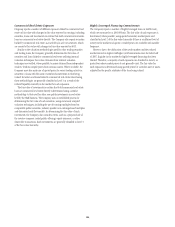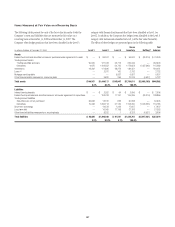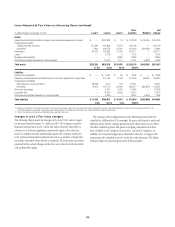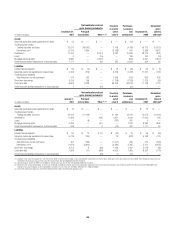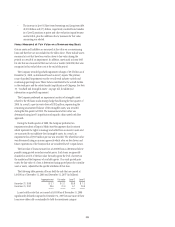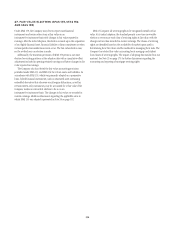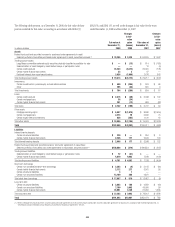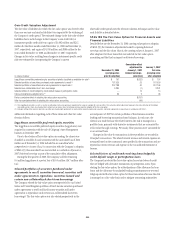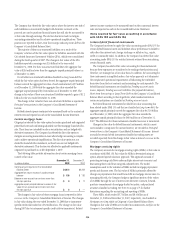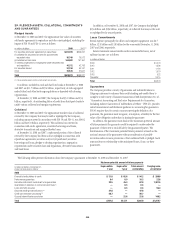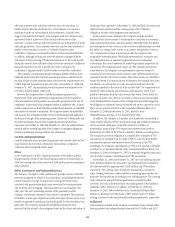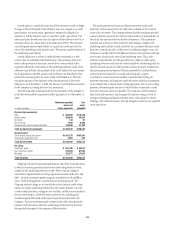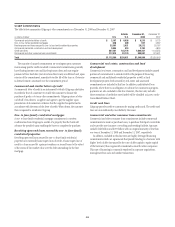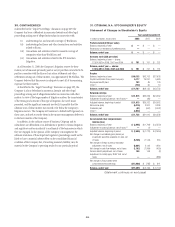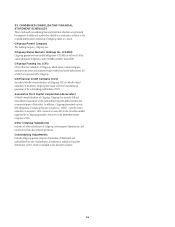Citibank 2008 Annual Report Download - page 212
Download and view the complete annual report
Please find page 212 of the 2008 Citibank annual report below. You can navigate through the pages in the report by either clicking on the pages listed below, or by using the keyword search tool below to find specific information within the annual report.
The Company has elected the fair-value option where the interest-rate risk of
such liabilities is economically hedged with derivative contracts or the
proceeds are used to purchase financial assets that will also be accounted for
at fair value through earnings. The election has been made to mitigate
accounting mismatches and to achieve operational simplifications. These
positions are reported in Short-term borrowings and Long-term debt on the
Company’s Consolidated Balance Sheet.
The majority of these non-structured liabilities are a result of the
Company’s election of the fair-value option for liabilities associated with the
Citi-advised Structured Investment Vehicles (SIVs), which were consolidated
during the fourth quarter of 2007. The change in fair values of the SIVs’
liabilities reported in earnings was $2.6 billion for the year ended
December 31, 2008. For these non-structured liabilities the aggregate fair
value is $263 million lower than the aggregate unpaid principal balance as
of December 31, 2008.
For all other non-structured liabilities classified as Long-term debt for
which the fair-value option has been elected, the aggregate unpaid principal
balance exceeds the aggregate fair value of such instruments by $97 million
as of December 31, 2008 while the aggregate fair value exceeded the
aggregate unpaid principal by $112 million as of December 31, 2007. The
change in fair value of these non-structured liabilities reported a gain of $1.2
billion for the year ended December 31, 2008.
The change in fair value for these non-structured liabilities is reported in
Principal transactions in the Company’s Consolidated Statement of
Income.
Related interest expense continues to be measured based on the contractual
interest rates and reported as such in the Consolidated Income Statement.
Certain mortgage loans
Citigroup has elected the fair-value option for certain purchased and originated
prime fixed-rate and conforming adjustable-rate first mortgage loans held-for-
sale. These loans are intended for sale or securitization and are hedged with
derivative instruments. The Company has elected the fair-value option to
mitigate accounting mismatches in cases where hedge accounting is complex
and to achieve operational simplifications. The fair-value option was not
elected for loans held-for-investment, as those loans are not hedged with
derivative instruments. This election was effective for applicable instruments
originated or purchased on or after September 1, 2007.
The following table provides information about certain mortgage loans
carried at fair value:
In millions of dollars
December 31,
2008
December 31,
2007
Carrying amount reported on the Consolidated
Balance Sheet $4,273 $6,392
Aggregate fair value in excess of unpaid principal
balance $ 138 $ 136
Balance on non-accrual loans or loans more than
90 days past due $9 $17
Aggregate unpaid principal balance in excess of fair
value for non-accrual loans or loans more than
90 days past due $2 $—
The changes in fair values of these mortgage loans is reported in Other
revenue in the Company’s Consolidated Statement of Income. The changes
in fair value during the year ended December 31, 2008 due to instrument-
specific credit risk resulted in a $32 million loss. The change in fair value
during 2007 due to instrument-specific credit risk was immaterial. Related
interest income continues to be measured based on the contractual interest
rates and reported as such in the Consolidated Income Statement.
Items selected for fair-value accounting in accordance
with SFAS 155 and SFAS 156
Certain hybrid financial instruments
The Company has elected to apply fair-value accounting under SFAS 155 for
certain hybrid financial assets and liabilities whose performance is linked to
risks other than interest rate, foreign exchange or inflation (e.g., equity,
credit or commodity risks). In addition, the Company has elected fair-value
accounting under SFAS 155 for residual interests retained from securitizing
certain financial assets.
The Company has elected fair-value accounting for these instruments
because these exposures are considered to be trading-related positions and,
therefore, are managed on a fair-value basis. In addition, the accounting for
these instruments is simplified under a fair-value approach as it eliminates
the complicated operational requirements of bifurcating the embedded
derivatives from the host contracts and accounting for each separately. The
hybrid financial instruments are classified as Trading account assets,
Loans,Deposits,Trading account liabilities (for prepaid derivatives),
Short-term borrowings or Long-Term Debt on the Company’s Consolidated
Balance Sheet according to their legal form, while residual interests in
certain securitizations are classified as Trading account assets.
For hybrid financial instruments for which fair-value accounting has
been elected under SFAS 155 and that are classified as Long-term debt, the
aggregate unpaid principal exceeds the aggregate fair value by $1.9 billion
as of December 31, 2008, while the aggregate fair value exceeds the
aggregate unpaid principal balance by $460 million as of December 31,
2007. The difference for those instruments classified as Loans is immaterial.
Changes in fair value for hybrid financial instruments, which in most
cases includes a component for accrued interest, are recorded in Principal
transactions in the Company’s Consolidated Statement of Income. Interest
accruals for certain hybrid instruments classified as trading assets are
recorded separately from the change in fair value as Interest revenue in the
Company’s Consolidated Statement of Income.
Mortgage servicing rights
The Company accounts for mortgage servicing rights (MSRs) at fair value in
accordance with SFAS 156. Fair value for MSRs is determined using an
option-adjusted spread valuation approach. This approach consists of
projecting servicing cash flows under multiple interest-rate scenarios and
discounting these cash flows using risk-adjusted rates. The model
assumptions used in the valuation of MSRs include mortgage prepayment
speeds and discount rates. The fair value of MSRs is primarily affected by
changes in prepayments that result from shifts in mortgage interest rates. In
managing this risk, the Company hedges a significant portion of the values
of its MSRs through the use of interest-rate derivative contracts, forward-
purchase commitments of mortgage-backed securities, and purchased
securities classified as trading. See Note 23 on page 175 for further
discussions regarding the accounting and reporting of MSRs.
These MSRs, which totaled $5.7 billion and $8.4 billion as of
December 31, 2008 and December 31, 2007, respectively, are classified as
Mortgage servicing rights on Citigroup’s Consolidated Balance Sheet.
Changes in fair value of MSRs are recorded in Commissions and fees in the
Company’s Consolidated Statement of Income.
206


